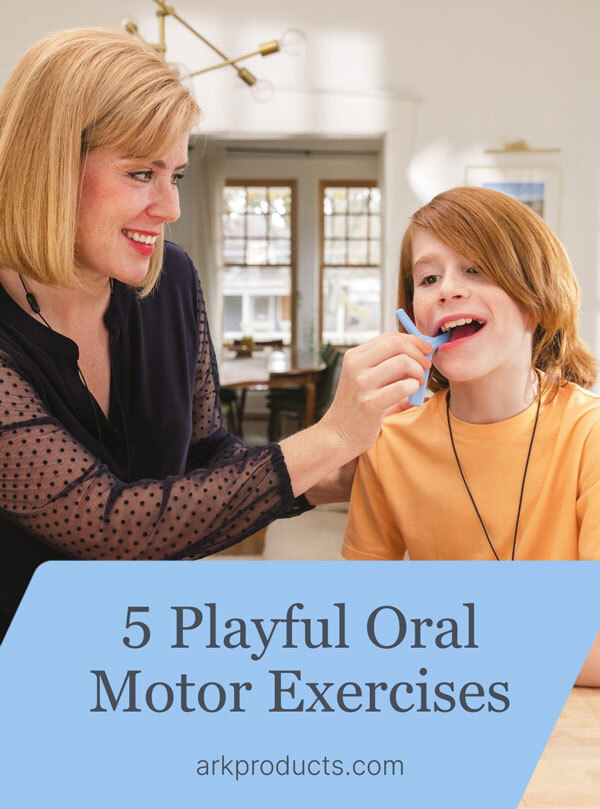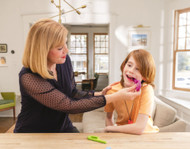5 Fun, Playful Oral Motor Exercises for Kids
Posted by Stephanie Feero, MS, CCC-SLP on 4th Sep 2025
Evidence tells us that engaging play in therapy yields better outcomes, and oral motor therapy should be no exception! My top priority in therapy is that my patients and I build trust while having playful, meaningful sessions to reach our goals! Oral motor therapy can be overstimulating, especially at the start of therapy, so I wanted to share a few of my fun-based ideas that I incorporate into feeding and oral motor therapy sessions so the kids have fun and we stay silly and playful as we make progress.
Bunny Hopping Through The Field - Vibrating Z-Vibe For Sensory Stimulation
Many of the children I’ve seen over the years have co-occurring sensory processing differences and it’s critical to make sure they feel comfortable starting oral motor therapy. Building trust and rapport with my clients through playful activities is my top priority in feeding and oral motor therapy because if we don’t have trust we won’t make progress!
I love playing “Bunny Hopping Through The Field” when I’m introducing the ARK Z-Vibe for sensory stimulation. I always start low on the child’s body, usually introducing the stimulation on the hand or lower arm and we make it a silly little game where we sing a song “Little bunny goes hop, hop,.....” and when the child says “hop!”, we move a little higher up the arms. We move higher up the arms, onto the shoulders, and eventually onto the cheeks and if the child can tolerate it, into the mouth.
This bunny hop activity is a great warm up activity to an oral motor session to be silly, build trust, and prepare the child for additional incoming oral sensations. It’s important to remember that building oral motor skills is a complex therapeutic process and vibration is one of many valuable tools to increase awareness, stimulate motor movement, and create a safe, sensory rich environment for a successful therapy journey!
Tennis Tongue - Ark Fine Tip For Lingual Lateralization
One of my favorite tips for the Z-Vibe, with or without vibration, is the Fine Tip. I use this tool to support lingual lateralization for bolus management and the development of a rotary mastication pattern. The Fine Tip is thin and easily fits in the oral cavity without taking up too much space and being cumbersome to the tongue’s movement.
Lingual lateralization is a common goal I target in oral motor therapy and it’s not always the most intuitive for feeding kids, so of course I want to make it as fun as possible! I love using the playful activity of “Tennis Tongue” where they imagine their tongue is a tennis ball and the Fine Tip is racket. I use this analogy to help them understand the back and forth movement and can use kid-friendly language like “oh no the ball is in the middle, it needs to find the racket!”
Depending on the child’s unique goals, I will use this activity to facilitate lingual lateralization both unilaterally and bilaterally, often with a mirror. The Fine Tip helps me guide their tongue and give them sensory feedback that they have met the placement goal.

Digging For Treasure - Maroon Spoon & Advancing Textures
Advancing textures and trialing new foods is at the core of my feeding therapy goals for most kids. It can often be a 2-part battle with feeding difficulties where oral motor deficiencies can hold children back from progressing in textures and then oral motor skills do not develop because the children hasn’t progressed into more challenging textures.
I love using the Maroon Spoon when advancing textures and trialing new foods. I always like to present the target foods on a plate and we get playful, and the Maroon Spoon’s shallow depth is perfect for ensuring appropriate bolus size.
For this activity we will present the session foods on a plate and the child and I “dig for treasure” in the food before taking a bite! We add a lot of descriptive language into the activity like “sticky, soft, big pile, small pile” etc. This makes the food exploration activity much more engaging and imaginative, which reduces the pressure on the child and often we will trial the food on the Maroon Spoon throughout the activity!
Chomping Beavers - Developing Chewing with the Grabber
In some cases we can start building jaw strength and stability even when the child isn’t able to tolerate the sensory experience of advanced textures, and the Grabber is a great tool to use for this! Sometimes I will dip the stem into juice to give it a little extra flavor and feedback.
To target jaw strength and stability in this activity, I will use the stem of the Grabber and tell the child it’s a log and our mission is to be beavers to chomp it down to build a dam! We get silly and pretend to be beavers, I show them my teeth and do silly faces and hands pretending to be a beaver chomping on wood, and the kids think it’s hilarious. We place the stem between the premolars and prompt the child “to break the log we need to chomp down 10 times!” and we count down. When the child reaches 10 we celebrate that the log is broken and we mark it down on a piece of paper to track how many logs we have for our dam. We repeat as needed for the child’s goals and it’s a playful, silly session! The Y-Chew is another great tool for this exercise.
Keep the Dragon In The Cave! - Supporting Lip Closure and Strength with the ProButton
Many of the children I have seen with oral motor difficulties present with poor labial closure and seal, along with mouth breathing patterns. Increasing labial seal can improve bolus management and promote a healthy nasal breathing respiratory pattern!
One of my favorite ARK products for this goal is the proButton products! I love to call this exercise “Dragon Cave” where we pretend the proButton is a dragon trying to escape the cave (the child’s mouth!). The child’s lips are the gates and they need to make sure the dragon doesn’t escape. We place the button in front of the teeth and the child closes their lips around the button, I then gently pull the proButton against the lips to target increasing strength, tone, and stability. If the proButton slips through the lips we get silly and make dragon noises and pretend the proButton is flying away like a dragon would - then we catch it and put it back in the cave where it belongs! We repeat this playful exercise to meet the child’s goals for the session!
Conclusion
I hope you enjoyed reading about some of my go-to names and play schemes to keep oral motor therapy fun and engaging for my pediatric patients. Each child is unique and therapy plans should be customized to fit the needs of each patient, but I’m a firm believer we can adapt a playful approach to any session!
Stephanie Feero, MS, CCC-SLP

Stephanie is a speech language pathologist in Washington state. She has worked with individuals with speech, feeding, and myofunctional disorders for the past 8 years of her career and has observed many patients greatly improve their speech and feeding skills with the use of oral motor intervention strategies!
Stephanie is also the creator of Chomper Champs - A Speech Therapy Companion Tool, which she developed to provide SLPs with engaging, quality speech products to target speech, language, feeding goals. You can find Stephanie at her website, chomperchamps.com or follow her on Instagram @chomper_champs_speechtherapy

